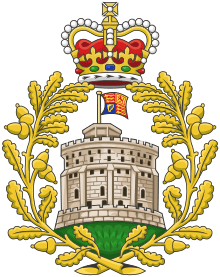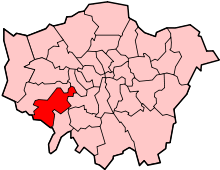The Queen's Beasts
.jpg)
The Queen's Beasts are ten heraldic statues representing the genealogy of Queen Elizabeth II. They stood in front of the temporary western annex to Westminster Abbey for the Queen's coronation in 1953.[1] Each of The Queen's Beasts consists of an heraldic beast supporting a shield bearing a badge or arms of a family associated with the ancestry of Queen Elizabeth II. They were commissioned by the British Ministry of Works from sculptor James Woodford (who was paid the sum of £2,750 for the work). They were uncoloured except for their shields at the coronation.[2]
Characteristics
The beasts are some six feet (1.8 m)[2] high and weigh about 700 pounds (320 kg)[3] each. They are works in plaster, and so cannot be left exposed to the elements. Originally uncolored except for their shields, they are now fully painted.
Display at the coronation
The Beasts were on display outside the western annexe of Westminster Abbey. The annexe was a glass fronted construction in which to marshal the long processions before the service. The statues were placed along the front with the exception of The Lion of England. It was placed in the alcove formed by the North wall of the annex and the entrance used by the Queen to enter the Abbey on her arrival in the Gold State Coach. The statues were placed left to right in the following order when facing the annex from the west: The Lion of England, the greyhound, the yale, the dragon, the horse, the lion of Mortimer, the unicorn, the griffin, the bull, and the falcon. [2][4] This was not the same order as they are in the royal pedigree, but were ordered in this way for balance and symmetry in display.[2]
Relocations
After the coronation, they were removed to the Great Hall in Hampton Court Palace. In 1957, they were moved again to St George's Hall, Windsor. The beasts were taken into storage in April 1958 while their future was considered. It was eventually decided to offer them to the Commonwealth governments; Canada, being the senior nation, was offered them first. In June 1959, the Canadian government accepted the beasts and they were shipped there in July. Originally, the only coloured parts of the statues were their heraldic shields; but, for the celebrations of the Canadian federation in 1967, the statues were painted in their full heraldic colours. They are now in the care of the Canadian Museum of History in Gatineau.
Replicas

In 1958, Sir Henry Ross, Chairman of the Distillers Company in Edinburgh, paid for Portland stone replicas of the statues, which are on display outside the Palm House at Kew Gardens. The beasts also served as models for topiary at Hall Place, Bexley. The original sculptures have been commemorated in the following forms: bone china figurines, cups and saucers, glass tray sets, plaster models, reclaimed material reproductions,[5] porcelain candlesticks, British postage stamps issued in 1998,[6] silver tea spoons, and tea towels. In 2016 the Royal Mint launched a series of ten Queen's Beasts bullion coins,[7] one for each beast.
Historical explanations
The Lion of England

The Lion of England is the crowned golden lion of England, which has been one of the supporters of the Royal Arms since the accession of James I in 1603. It supports a shield showing the Arms of the United Kingdom as they have been since Queen Victoria's accession in 1837. In the first and last quarters of the shield are the lions of England. The lion and tressure of Scotland appear in the second, and the harp of Ireland is in the third.[2]
The White Greyhound of Richmond

The White Greyhound of Richmond was a badge of John of Gaunt, Earl of Richmond, son of Edward III. It was also used by Henry IV and especially by Henry VII. The Tudor double rose can be seen on the shield, one rose within another surmounted by a crown. It symbolizes the union of two of the cadet houses of the Plantagenet, York and Lancaster.[2]
The Yale of Beaufort

The Yale was a mythical beast, supposedly white and covered with gold spots and able to swivel each of its horns independently. It descends to the Queen through Henry VII, who inherited it from his mother, Lady Margaret Beaufort. The shield shows a portcullis surmounted by a royal crown. The portcullis (uncrowned) was a Beaufort badge, but was used both crowned and uncrowned by Henry VII.[2]
The Red Dragon of Wales

The red dragon was a badge used by Owen Tudor. His grandson, Henry VII, took it as a token of his supposed descent from Cadwaladr, the last of the line of Maelgwn. The beast holds a shield bearing a leopard in each quarter; this was the coat of arms of Llywelyn ap Gruffudd, the last native Prince of Wales.[2]
The White Horse of Hanover
.svg.png)
The White Horse of Hanover was introduced into the Royal Arms in 1714 when the crown of Great Britain passed to the Elector George of Hanover. This grandson of Elizabeth Stuart, sister of Charles I, became George I, King of Britain, France and Ireland. The shield shows the leopards of England and the lion of Scotland in the first quarter, the fleur-de-lis of France in the second and the Irish harp in the third quarter. The fourth quarter shows the Arms of Hanover.[2]
The White Lion of Mortimer

The White Lion of Mortimer descends to the Queen through Edward IV. The shield shows a white rose encircled by a golden sun, known heraldically as a ‘white rose en soleil’ which is really a combination of two distinct badges. Both of these appear on the Great Seals of Edward IV and Richard III, and were used by George VI when Duke of York. Unlike the Lion of England, this beast is uncrowned.[2]
The Unicorn of Scotland

From the end of the 16th century, two unicorns were adopted as the supporters of the Scottish Royal Arms. In 1603, the crown of England passed to James VI of Scotland, who then became James I of England. He took as supporters of his Royal Arms a crowned lion of England and one of his Scottish unicorns. The unicorn holds a shield showing the Royal Arms of Scotland, a lion ramping in a royal tressure, adorned with fleur-de-lis.[2]
The Griffin of Edward III

The griffin of Edward III Queen's Beast is an ancient mythical beast. It was considered a beneficent creature, signifying courage and strength combined with guardianship, vigilance, swiftness and keen vision. It was closely associated with Edward III who engraved it on his private seal. The shield shows the Round Tower of Windsor Castle (where Edward III was born) with the Royal Standard flying from the turret, enclosed by two branches of oak surmounted by the royal crown.[2]
The Black Bull of Clarence
.svg.png)
The Black Bull of Clarence descended to the Queen through Edward IV. The shield shows the Royal Arms as they were borne by Edward IV and his brother Richard III as well as all the Sovereigns of the Houses of Lancaster and Tudor.[2]
The Falcon of the Plantagenets

The falcon was first used by Edward III of the House of Plantagenet as his badge. It descended to Edward IV, who took it as his personal badge, the falcon being seated within an open fetterlock. The slightly open fetterlock is supposed to refer to the struggle Edward IV had to obtain the throne — "he forced the lock and won the throne."[2]
See also
- Canadian royal symbols
- The Royal Mint
- List of public art in Richmond upon Thames
- Royal Badges of England
- The King's Beasts, Hampton Court
- The Queen's Beasts, St George's Chapel
References
- ↑ "Elizabeth II". Retrieved 2016-09-11.
- 1 2 3 4 5 6 7 8 9 10 11 12 13 14 London, H. Stanford (1953-01-01). The Queen's Beasts (First Edition edition ed.). Newman Neame.
- ↑ "Heraldry Projects: Queen's Beasts". www.heraldry.ca. Retrieved 2016-09-11.
- ↑ Parks and Gardens UK (2014-11-01). "More heraldic beasts…". Parks and Gardens UK. Retrieved 2016-09-11.
- ↑ "Huntingdonshire artist recreates The Queen's beasts", Hunt Post, 19 May 2012, retrieved 12 June 2012
- ↑ "The Queens Beasts (1998) : Collect GB Stamps". www.collectgbstamps.co.uk. Retrieved 2016-08-17.
- ↑ "The Queen's Beasts are brought to life in a new bullion coin range", Royal Mint Blog, 31 March 2016, retrieved 1 April 2016
External links
- Queen's Beasts trivia Quiz
- The Royal Heraldry Society of Canada: Preparing the Queen's Beasts for the Diamond Jubilee
- Canadian Museum of History: A Queen and Her Country (includes colour images of the Queen's Beasts)
- Queen's Beasts Coins on Royal Mint Bullion
- Photo of The Queen's Beasts in from of the annexe
- Queen's Beasts And Robes (1953)
- Abbey Coronation Annexe Newsreel (1952)
